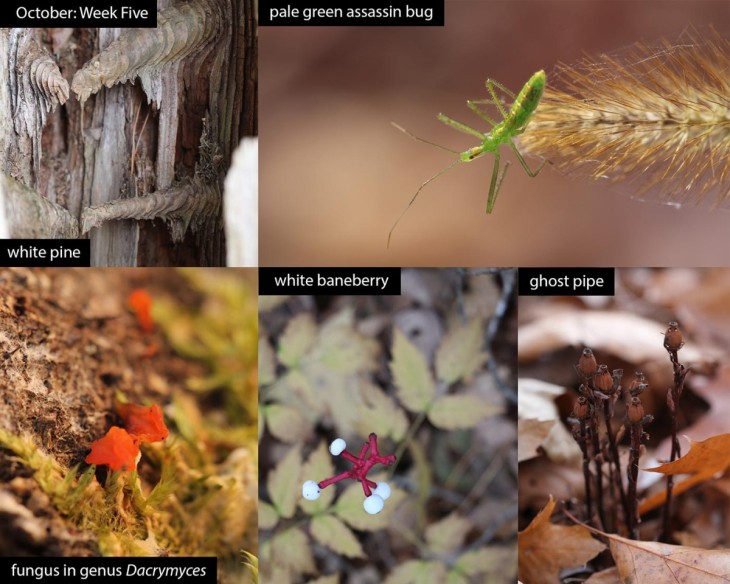This week in the woods, a white pine snag with much of its bole rotted away displayed some of its branch rings in three dimensions. In lumber, we would see these conical features in cross section, as knots. The places where grain in the branches continues into the wood below indicate years when an encased limb was alive at the same time as the rest of the tree; these lower limbs likely would have died when shaded out later in the tree’s life, as it became an overstory tree and self-pruned. Just as trees in our temperate climate produce growth rings each year, white pines (and red pines) also produce whorls of branches annually; the vertical distance between the two sets of branches here represents a year’s growth. While not always a reliable technique once the tree loses and grows over dead branches, counting whorls up a living pine’s trunk is one way to estimate its age without seeing its rings.
Not far away, in a forest opening, we saw this pale green assassin bug nymph. Before we could get a good photograph, it had sucked the life out of an arachnid. We can see in this photo its semitransparent abdomen darkened by its prey, as well as remnants of the dead spider’s web on the foxtail. Some assassin bugs pretend to be caught in spiders’ webs in order to lure them into attack range.
Foliage has subsided to mostly the lingering dull orange of beech and brown of oak, but the forest floor still offers fluctuating color: jelly fungus in the genus Dacrymyces emerging from a hemlock log’s end; white baneberry (or doll’s eyes), poisonous to us but not to birds or rodents, which may have carried off a set of these berries from the striking magenta stems; and fertilized ghost pipe trading summer white for a winter brown.
This time of year, you may also notice striped skunks more often. Young born in the spring are now leaving their mothers and dispersing, and preparation for entering torpor has begun in earnest. Out looking aggressively for dwindling food supplies and, eventually, winter burrows, they are frequently on the move at night, which makes them especially prone to encounters with vehicles and dogs. If you see that bright white stripe emerging from the dark, keep your pet close and move away slowly and quietly.
What have you noticed in the woods this week? Submit a recent photo for possible inclusion in our monthly online Reader Photo Gallery.


